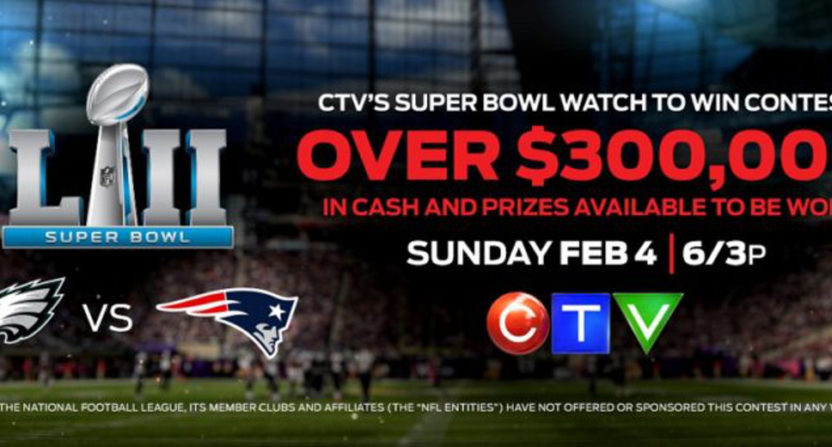One of the more unusual broadcasting angles around the Super Bowl is in Canada, where NFL rightsholder Bell saw a 39 per cent audience drop last year thanks largely to a Canadian Radio-television and Telecommunications Commission (CRTC) ruling that banned the practice of simultaneous substitution (simsub) for the Super Bowl only. Canadian television viewers have long been able to watch American broadcast networks, but the long-standing simsub practice means that Canadian networks showing the same programming (and U.S. programming makes up a lot of private-sector Canadian networks’ airtime) can push their ads onto the U.S. feeds and count the viewers watching those. That’s not a big deal for most programming, where both the U.S. and Canadian ads aren’t something people really seek out, but when it comes to the Super Bowl, it’s led to decades of complaints from Canadian viewers unable to watch the high-budget, high-concept American ads on TV.
That led to the CRTC ruling, which first took effect last year and will be in effect for at least this year, after an appeals court ruled against Bell and the NFL in December and their petition for the Supreme Court of Canada to issue a stay was dismissed late last week.
This is a big deal for Bell, and it matters for the NFL as well (which is why they’ve been involved in the various legal appeals here). Bell received a Super Bowl audience of 4.47 million viewers on average last year, almost 40 per cent below the 7.32 million they pulled in for Super Bowl 50 in 2016. And that was despite the game being broadcast across CTV, TSN, and CTV Two for the first time ever. Now, the U.S. ratings were slightly down when it came to average viewers last year as well, but only by about 600,000 viewers (111.9 million to 111.3 million), so while the matchup and game may have played somewhat of a role in that Canadian decline, it seems most of it is about the ads.
And many Canadian media observers were surprised the decline was only 39 per cent; the broadcasts are identical in almost every other respect (CTV doesn’t send their own game announcers or production trucks for the NFL, instead picking up U.S. feeds), so there was a large case for viewers to choose the high-budget, much-discussed U.S. ads over the Canadian ones. It’s possible that the shift to the U.S. feeds could be even larger this year, as there’s now been another full year of coverage indicating that this is now an option for Canadian viewers.
The latest
And that’s why the NFL has been aggressively lobbying to reverse this ruling, and has even received backing from U.S. politicians like Florida senator Marco Rubio. Without simsub, the NFL is losing audience (the Canadian viewers who choose to watch the U.S. Super Bowl feeds aren’t counted by U.S. ratings agency Nielsen or Canadian ratings agency Numeris) and ad dollars (even if those Canadian viewers are watching the U.S. feeds, they’re not a tracked audience and not the audience U.S. national advertisers are paying for; there can be a bit of a boost in local ads for near-border U.S. stations, as some Canadian companies bought those ads last year, but that’s still a decline in ad revenue overall), and that hurts it in future rights negotiations. No Super Bowl simsub allows Canadian viewers more choice, but it’s definitely a negative for both Bell and the NFL. And that’s why they’re still fighting to overturn it down the road; this stay wasn’t granted, so there will be no simsub this year, but the Supreme Court hasn’t declined to hear the appeal yet, so there’s still a chance that this could change ahead of the 2019 Super Bowl.
Interestingly enough, though, this has led to Bell making some broadcast innovations to try and keep as much of the Canadian audience as they can. Last year, they launched a “Watch To Win” contest, handing out prizes to viewers who watched the CTV/TSN feeds, and they’re doing that again this year, offering over $300,000 Canadian ($243,000 U.S.) in cash and prizes (including a trip to next year’s Super Bowl and a grand cash prize of $150,000). And they’ve hired comedian Russell Peters (who’s Canadian, you know) for a series of humor (or humour, depending on which side of the border you’re reading this on) segments that will appear during the broadcast. Bell is also even promoting a way for viewers to watch U.S. ads while sticking with the Canadian feed:
Leading up to SUPER BOWL LII, Canadian fans can visit BigGameAds.ca to keep up to date on all of the American SUPER BOWL ads released in advance of the big game. In addition to the 2018 ads, the site also features fan-favourite ads from years past.
So, while this move has been a blow for Bell and the NFL, it’s produced some benefits for Canadian viewers. First, it’s addressed the decades-long complaints about not being able to watch American Super Bowl ads (which actually made up a significant percentage of the overall feedback to the CRTC, leading to this decision). Second, it’s prompted Bell to create some unique content that people might actually want to watch with things like the Peters bits, rather than just taking the U.S. feed completely and running their ads on it. Third, it’s prompted some Canadian companies to step up their own ad game for the Super Bowl; many of the ads during the game have still been the standard fare you regularly see on Canadian TV, but some have already gone the extra mile to try and create compelling ads, and if the simsub ban continues, it seems likely that trend will continue as well. And fourth, this move’s prompted Bell to offer this loyalty contest to try and retain viewers, so there are a whole lot of significant prizes that wouldn’t have existed if not for this ruling.
We’ll see how many people stick with the Canadian feed this year, and what the court eventually decides about the future of Super Bowl simsub, but at the very least, this has made for a couple of years of interesting drama. Oh, and speaking of drama, like NBC, CTV will be following the Super Bowl with the hotly-anticipated episode of This Is Us where we finally see how Jack dies, continuing the history of depressing post-Super Bowl programming and the need to yell at brands over fictional events. And hey, at least they get to use simsub for that one.







